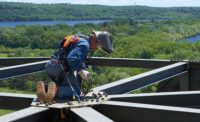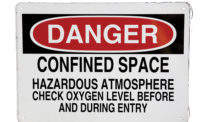
Hard hats are the most easily recognized personal protective equipment (PPE) on the construction site. They are such a common symbol of construction that the term “hard hat” has long been a synonym for “construction worker.”
While a common sight and a relatively simple piece of safety equipment, the hard hat cannot be taken for granted. According to the U.S. Bureau of Labor Statistics, in 2007 head injuries still accounted for almost 8 percent of nonfatal injuries in the construction workforce.
Hard hats are designed to protect the top of the head against falling objects and protect the side of the head, eyes and neck from impacts, bumps, scrapes and splashes. But hard hats can only offer protection when they are properly selected, worn and maintained.
Hard hat selection
There are two main styles of hard hats — the cap version with a partial brim (like a baseball cap) and the full brim version where the brim encircles the entire hat. For outdoor work, the full brim offers additional protection to the eyes and skin from excessive exposure to the sun.
Hard hat specifications should meet the current requirements of the American National Standards Institute (ANSI)/International Safety Equipment Association (ISEA) standard Z89.1-2009 American National Standard for Industrial Head Protection. Hard hats meeting these requirements will be marked or have a sticker inside the helmet.
Hard hats should not be confused with “bump caps.” Bump caps are used in areas with low head clearance. They are not designed to withstand penetration or impact and do not meet ANSI/ISEA Z89.1-2009 requirements.
The 2009 revision ANSI/ISEA Z89.1 specifies two types and three classes of hard hats:
- Type I reduces the force of impact to the top of the head.
- Type II reduces the force of impact to the top and sides of the head.
After selecting the appropriate type of hard hat, the electrical class must be considered.
- G (general) is designed to protect against contact with low voltage and is proof-tested to 2,200 volts.
- E (electrical) is designed to reduce danger of contact with high voltage sources and is proof-tested to 20,000 volts.
- C (conductive) offers no protection against contact with electrical conductors.
Optional features
Hard hats offer the following additional options for comfort and flexibility:
- Suspension systems that allow the hat to be worn backwards (brim to the rear). This is useful when the brim interferes with lines of sight, use of other equipment or tools, or when workers just want to have “the look”. Safety professionals must verify that the manufacturer has tested and certified that the hat and suspension will provide adequate protection in this configuration via a double reverse arrow symbol after the ANSI/ISEA Z89.1-2009 marking. This almost always requires reversing the suspension system which is still worn in the brow band forward position.
- Ventilation holes in the top of the hat to aid in cooling. These holes automatically classify the hard hat as Class C. If electrical conductivity protection is required, ventilation holes are not an option.
- Attachment points or accessory slots to allow earmuffs, face shields or welding helmets to be worn simultaneously with hard hats.
- UV exposure indicators. Ultraviolet rays can accelerate plastic deterioration. Until recently, determining significant deterioration was a subjective decision. Hard hats can now be equipped with a UV sensor that changes color when exposures require that the hat be replaced.
Hard hats are designed as a system where the shell and suspension work together. Parts from different manufacturers should not be mixed (i.e. suspensions from one manufacturer should not be used with shells from another manufacturer). Doing this may create a situation where protection is severely compromised.
Similarly, the shell and suspension are designed to work with specific clearances that allow the hard hat to compress during impact and absorb some of the shock without transferring it to the head or neck of the wearer. Using this clearance area as a storage space for other things (gloves, earplugs, etc.) can reduce the shock absorption capacity and increase the risk to the wearer.
Many companies use hard hat stickers as motivational tools or to verify that a person has completed training and is authorized to work in a specific area. Usually sticker adhesives will not create any problems as long as they do not hide cracks or other signs of deterioration. Stickers should be placed away from the edge of the hat and not wrapped around to the inside to prevent the sticker from conducting electrical current to the inside of the shell.
Maintenance
Like all PPE, hard hats need to be inspected on a regular basis and repaired or replaced when parts become damaged or worn. Hard hats subject to forceful impact — from something falling on it or the hard hat itself falling — should be immediately taken out of service and replaced regardless of visual appearance. For hard hats currently in service, some signs to look for during routine inspection include:
- Cracks, dents, deep abrasions, brittleness, chalky appearance, penetrations or color fading in the shell that may indicate damage or the start of plastic degradation. Hard hats exposed to harsh environments such as airborne chemicals, extreme temperatures (hot or cold) or repeated, prolonged exposure to sunlight should be checked more frequently. While there is no regulatory requirement for when to replace the shell, most manufacturers recommend routine replacement every two to five years, depending on use conditions.
- Frayed, torn or damaged crown straps in the suspension. The keys (the tabs on the crown strap that fit into slots on the hard hat) should be intact and firmly locked into place. The head band should be flexible, and the size adjustment mechanism able to maintain the selected size. At least one manufacturer recommends replacing the entire suspension system annually.
- Used as a chair or step — the compression may damage the shell.
- Cleaned with solvents or abrasive cleaners. Follow the recommendations of the hard hat manufacturer. A pH neutral soap and warm water (120°F) will usually get the job done.
- Painted, drilled or otherwise customized.
- Stored in areas subject to environmental extremes.
Further Reading
Occupational Safety and Health Administration (OSHA) “OSHA Standards Interpretation and Compliance Letters 07/22/1992 – The use of head protection at construction sites.
Occupational Safety and Health Administration (OSHA). Personal Protective Equipment Publication 3151-12R 2003.


